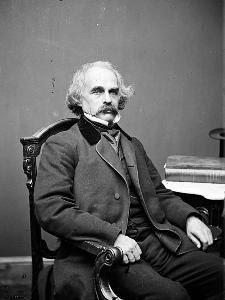Tracing the Roots of Your Favorite American Author, Part 2
Tracing the Roots of Your Favorite American Author, Part 2
Edgar Allan Poe
“All that we see or seem is but a dream within a dream.”
The author of many “dark” poems and short stories, including my favorite short story of all time, Tell Tale Heart, Edgar Allan Poe’s life is a story in itself. Two years after his birth in Boston 1809, Edgar Allan Poe’s actress mother died. Poe and his siblings were abandoned by their father. Edgar was taken in and raised by the John Allan family, though they never adopted him legally. He attended the University of Virginia but was unable to complete his education there due to lack of funds. After John Allan refused to help him pay tuition, Edgar decided to continue on to Boston where he published his first small book of poetry before joining to US Army. He attended Westpoint Academy for a while, where he published a second book of poetry before leaving the school without completing his education. A third poetry book soon followed while the author was living with his aunt in Baltimore. He married his cousin, Virginia in 1836. After her death in 1847, Poe turned to alcohol for comfort and was distraught and unstable. All throughout his writing career, he received deep criticism from literary critics, though today he remains one of the world’s most celebrated authors.
Because the author lived in several states, those who wish to take an in-depth look into his life will find his roots scattered in Richmond, VA, Baltimore, MD, Philadelphia, PA and Boston, MA.
Pennsylvania
The US National Park System established the Edgar Allan Poe National Historic Site in 1980. This is the only one of several former Poe residences that remains standing. He lived here in 1843, and it now houses a reading room with his complete works and several exhibits.
Virginia
The Poe Museum in Richmond, VA offers visitors one of the largest collections of Poe memorabilia in the USA.
Maryland
If your travels find you in Baltimore, check out the Poe Society of Baltimore. From here you can explore several sites relating to the author. You’ll want to visit the Poe House and Museum, which was fortunately spared demolition and restored by the Poe Society. This is where Poe lived with his aunt in the 1830’s. Some of the author’s possessions are displayed in the house. He wrote a number of stories and poems while living here. Note that the house is closed from mid December – March. The museum hosts Edgar Allan Poe’s Birthday Party Celebration every year on the weekend closed to January 19th.
At Poe’s Memorial Grave, you can view the monument that was placed in his honor, years after his death. His original nearby unmarked grave was neglected for years before a woman named Sara Sigourney Rice led a campaign to clean it up and erect a beautiful monument.
A bronze Statue of Poe resides at the University of Baltimore’s Law School. It was created by sculptor Sir Moses Jacob Ezekiel. The statue was once displayed at Wyman Park, but was vandalized and in disrepair.
The Church Hospital where Poe passed away is now owned by Johns Hopkins Hospital but is not open to the general public. You can drive by to see the restored historic structure.
Boston
If you are in Boston or will be there very soon, hurry over to check out the Poe Exhibit at the Boston Public Library. The exhibit lasts only through the end of March and features the great author’s struggles with literary critics throughout his writing career.
Nathaniel Hawthorne
“Easy reading is damn hard writing.”

Nathaniel Hathorne was born in Salem, MA in 1804 to his mother, Elizabeth, and father, a sea captain also named Nathaniel Hathorne. His father died when Nathaniel Jr. was only 4, and due to a lack of money, his mother moved the family back to her childhood home next door. The family later moved to Maine, and Nathaniel earned his degree at Bowdoin College. It was here that he befriended both Henry Wadsworth Longfellow and Franklin Pierce. He later also became friends with Henry David Thoreau and Ralph Waldo Emerson. It is truly astonishing that so many great writers not only lived at the same time, but also knew each other well.
While in his 20s, Nathaniel changed the spelling of his name to include the Elizabethan spelling by adding a “W,” much to the displeasure of his family. It was his way of rejecting his Puritan heritage and the fact that his father served as a judge during the Salem Witch Trials of 1692.
Similar to fellow American author Edgar Allan Poe, Nathaniel Hawthorne was inspired by woeful part of the human spirit. His two most famous works, The Scarlet Letter and The House with Seven Gables were well received by critics. His writing is referred to as “dark" - Poe himself wrote a favorable review of Hawthorne’s Twice Told Tales in 1837.
For a time, Hawthorne lived in the Old Manse in Concord, MA where he met and married Sophia Peabody in 1842. The couple soon returned to Salem due to financial troubles and later moved to England. He passed away in 1864 at a house in Plymouth, New Hampshire.
To travel back in time to Hawthorne’s life, plan a trip to Salem, MA. You can find out more information at an excellent website, Hawthorne in Salem
Start with the childhood home of Hawthorne, the House of the Seven Gables Historic Site, where you will receive an excellent guided tour. It was built in 1668 and contains furnishings one would find in the 1840s.
Hawthorne once lived next door to the The Robert Manning House. It was occupied by a well-known horticulturist, Robert Manning, Sr. and often visited by the author.
The historical records Hawthorne used to help him write the Scarlet Letter were discovered at the Salem Custom House, with its Federal style of architecture. For a time, Hawthorne worked here.
There are many other buildings from Hawthorne’s time that remain standing in Salem, and you can take a walking tour of many of them.
Be sure to also visit the Salem Maritime National Historic Site, which will give you insight into the maritime life of the people of Salem during Nathaniel Hawthorne’s life.
The Phillips Library in the Peabody Essex Museum is a great source of information about the author. There was an excellent exhibit here for the author’s bicentennial celebration in 2004. Today you can purchase some items relating to Hawthorne in the museum gift shop.
If you travel to Concord, you can tour The Old Manse, where Nathaniel lived for a time with his wife, Sophia after their wedding. Today it is a national historic landmark, and includes a vegetable garden similar to the one Thoreau created for the couple as a wedding gift.
Whoever your favorite American authors may be, you’re sure to enjoy a journey of pilgrimage to their lives in the historical sites our great nation has preserved in their honor.
Click here to read
Tracing the Roots of Your Favorite American Author, Part 1
Debbie Glade is the Geography Awareness Editor for Wandering Educators
Photos Library of Congress Public Domain
-

- Log in to post comments


















